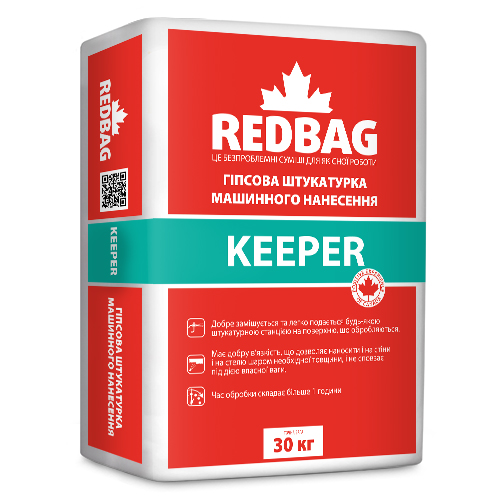Work should be carried out at a base temperature of +10 °C to +30 °C.
Layer thickness from 5 to 30 mm per application.
Manual application. The mortar mixture is applied to the prepared surface using a ladle, spatula and leveled using a rule or a half-trowel. Approximately 60-100 minutes after mixing the mixture, level the layer of applied material with a metal trapezoidal rail, cutting off irregularities and filling in depressions. If the surface is being prepared for painting, then after leveling, wait for approximately 15 minutes and moisten the plaster surface with water and rub in circular motions with a sponge trowel to eliminate minor irregularities. After a short exposure until a matte surface appears, smooth the plaster with a wide spatula or metal trowel. To obtain a smooth surface, it is permissible at the end of the mortar hardening process (approximately 4-5 hours after mixing the mixture), to moisten the plaster surface abundantly with water and smooth it with a spatula or trowel.
Application by machine. With the mechanized method of work, any plastering station can be used to apply plaster. Plastering walls with a nozzle is usually carried out from left to right and from top to bottom, holding the spray gun perpendicular to the surface at a distance of 10-30 cm and forming strokes about 100 cm wide. The thickness of the plaster layer is regulated by the speed of movement of the gun. The work is carried out in such a way that the trace of the plaster spray moves along the lower edge of the strip of already applied mortar, the “caterpillar” method. Each subsequent stroke is applied with an overlap of the previous one by 2-3 cm. Approximately 60-100 minutes after mixing the mixture, level the layer of applied material with a metal trapezoidal rail, cutting off irregularities and filling in depressions. If the surface is being prepared for painting, after leveling, wait for approximately 15 minutes and moisten the plaster surface with water and rub in circular motions with a sponge trowel to eliminate minor irregularities. After a short exposure until a matte surface appears, smooth the plaster with a wide spatula or metal trowel. To obtain a smooth surface, it is permissible to moisten the plaster surface abundantly with water at the end of the hardening process of the solution (approximately 4-5 hours after mixing the mixture), and smooth it with a spatula or trowel.
The thickness of one layer of plaster should be from 5 to 30 mm. Surfaces with differences in the plane of more than 30 mm should be leveled in several layers, while the next layer should be applied immediately after the previous one has hardened (approximately 6 hours after mixing the mixture, depending on the water absorption of the surface and the temperature in the room). When applying several layers, do not level the previous layer.
During breaks in work for more than 20 minutes and after finishing work, the tool must be cleaned and rinsed with water.
At low temperatures, direct heating of the plaster surface should not be allowed. To speed up the drying of the plaster, ensure sufficient ventilation of the room.







